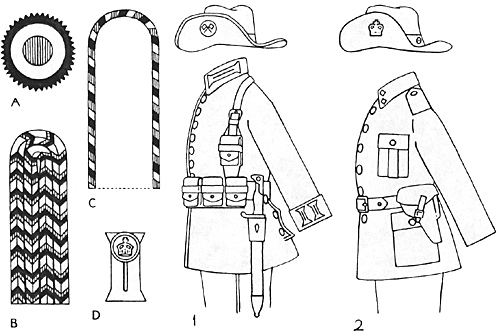German Protective Force (Schutztruppe) in South West Africa 1896 to 1915 wore the same uniform and equipment illustrated in (1), with the following differences - cornflower blue hatband, hat badge was the black-white-red national cockade (A), black-white-red mix shoulder cords (B), white metal buttons on the cuff patches (D). They would also have a company bayonet knot as in the army, tied to their bayonet frog. The One-Year Volunteers in South West Africa wore the troopers uniform, but were identified by a black-white-red twisted cord around each shoulder strap (C).
(In addition to the light gray troopers uniform there was a khaki one as well; all khaki, with cornflower blue piping, and the same shoulder cords as the gray - see "B". Beginning in 1889, in South West Africa, the light gray uniform was worn in the cold season, the khaki during the warm. At the close of 1913 the light gray color (officially called sand gray) was changed to the field gray of the army. Field gray at this time was a dark gray. However, despite the change to field gray, most NCOs and men continued to wear the light gray uniform well into 1914.)

German Colonial Uniforms in South West Africa
- Imperial Commissioner's Unit
Imperial Protective Force (Schutztruppe) 1894
Protective Force (Schutztruppe) 2d Lieut., Campaign Dress 1904-1908
Volunteer Corps 1914-1915
Schutztruppe 1896-1915
Police Sergeant-Major 1907-1915
Back to The Heliograph's German Colonial Military Uniforms: Africa Table of Contents
Back to The Heliograph List of Issues
Back to Master Magazine List
© Copyright 2003 by Richard Brooks.
This article appears in MagWeb.com (Magazine Web) on the Internet World Wide Web.
Other articles from military history and related magazines are available at http://www.magweb.com